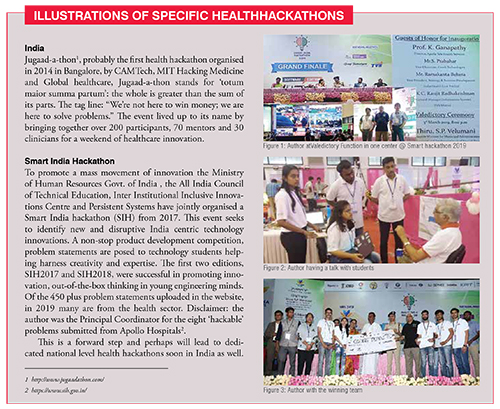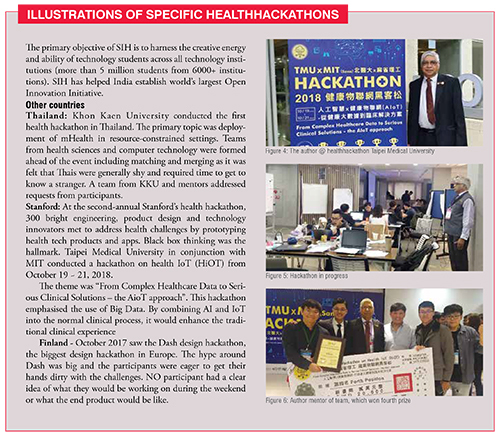The very concept of a hackathon first originated in 1999. In 2010, the first dedicated health hackathon took place. While there are many URL’s which invites applications for specific individual health hackathons and some, which describe in informal language what occurred during the hackathon, the number of articles published on health hackathons per se are not many. This overview is a synopsis of the information currently available also utilising the author’s participation as a mentor and judge in an international and national health hackathon. The article is from the perspective of an IT interested clinician.
The term ‘hack’ generally signifies writing a computer programme for enjoyment while ‘thon’ is taken from the word ‘Marathon’ denoting a specific, clearly defined, difficult, time-restricted objective involving concentrated effort. The prefix ‘hack’ sometimes results in an erroneous misconception that this activity is related to unauthorised intrusion into a computer or a network.
A hackathon is a design sprint1-like event in which computer programmers, project managers, healthcare providers, data scientists, technologists, businessmen, subjectmatter-experts and other stake holders collaborate intensively on software projects. A working product needs to be developed before the hackathon is over, deploying appropriate software or hardware. Programming language, operating system and API used are normally specific to the event. Creating new areas for innovation and funding is the primary goal. In many ways, hackers are model citizens of the digital era. They are creative, persistent, and resourceful, viewing every problem as an opportunity. A health hackathon aims at productising high impact innovations better than existing alternatives, relevant to the local context, simple, easily tested, and visible to others.
The ‘hacker way’ has been successful outside of healthcare, because the developer or hacker can identify themselves as the final user of the product or service. Developers for the most part create products that they themselves would use. In travel, banking, media, and social networking the developers have easy access to the fundamental users: either themselves or the people around them. However, in health, there is a barrier of access to users. Fundamentally, those with technical skills to build solutions are separated from those who have the frontline experience and understanding, to know which solutions should be built. In healthcare even if a hacker could develop a solution, it cannot be tested and implemented without a clinical partner. Each needs the other to move from idea to a working product
Hackathons have a lot in common with the ‘Lean Startup’ philosophy. Basically, it revolves round the statement “how can we learn more quickly what works, and discard what does not?”Lean startup is a methodology for developing businesses and products. A minimum viable product (MVP) is developed with sufficient features to satisfy early adopters. The final, complete set of features is designed and developed after getting feedback. High morale, safety, and customer delight are additional goals and benefits. The Lean-agile mindset, which provides tools needed to empower and engage teams to achieve high productivity, quality, and engagement is also desirable while participating in a healthhackathon. John Gage of Sun Microsystems is credited with introducing the term ‘hackathon’ in 1999 at a programmers conference in Silicon Valley. It wasn’t until 2010 that the first health focused hackathons was launched at a national scale.
The complex issues in healthcare need multiple solutions at multiple times. A healthcare solution is not just a function of deployment of hard-core software programming. Scientific, economic, political, emotional, and ethical issues need to be addressed. A number of perspectives need to be integrated. Working in crossfunctional teams and testing of ideas leads to development of complete functional prototypes. hackathons offer an opportunity for spotting talent and creating new opportunities. Non-clinicians can begin to understand the complexities of the clinical thought process and the factors that drive quality improvement.
A few days even of concentrated, cross-disciplinary creativity is unlikely to yield necessary proof. Ideas are in plenty. Proving that the proposed healthcare intervention work is more difficult than demonstrating working of a software code or a business model. Hackathons are a great way to generate a spark. But in medicine, it’s a long way from spark to fire. Innovations are the end result of likeminded people coming together. Perspectives may be different but goals are the same.
The hacker way is a model for rapidly solving problems through intense, inexpensive sessions. Programmers and web designers get together, without prior planning and with total freedom. Facebook, a US$100billion corporate giant, started in a dormitory room. Thousands of small improvements made Facebook what it is today. Healthcare providers can define a problem and suggest solutions but do not have access to people who can develop solutions. Individuals with solutions cannot get close to the health-care system. In a health hackathon, they are together.
Hackathons are not just for coders. All organisations are starting to use these intense brainstorming and development sessions to create new ideas. A concept is being translated into new products and processes that improve customer experience, increasing growth. Participants need to step out of their normal roles and skill sets – outside their “comfort zone. Asking the right question is critical. The best hackathons start with an openended but clear challenge. The question should be focused and inspiring, with multiple solutions. If new information is forthcoming the original question itself could be reviewed.
Opportunities need to be provided for new learning. A hackathon is a refuelling pit stop/ training session to prepare participants for solving problems. Every participant needs to be occupied with building new data, writing a document or jointly investigating a problem. The problem must be precise, unambiguous with possibility of a reasonably specific solution. A “subject matter expert” guides the project to realworld relevance, identifying problems. However, they may not be able to convert these into workable technology projects. Ideas discussed should be confined to those, which can actually be worked upon during the hackathon.

At the beginning of a healthhackathon, mentors define a problem in one minute. Participants also suggest ways of tackling the problem. They then divide themselves into groups based on problems they are interested in solving. Competition adds to the challenge. Teams with the best ideas win cash prizes and opportunities to promote a start-up company. The main work may take several hours to several days. Participants sleep on-site bringing adequate clothes and power strips! As most of the ‘hackers’ are millennials, there is a general air of informality.
Each team consists of 4-5 individuals of diversified backgrounds. It is presupposed that the ‘problem’ experts will understand the language spoken by the solution providers and vice versa. An entrance fee, primarily to defray operational expenses and food, is collected from the participants. This varies from US$ 25 for a student to 100$ for a non-student. Companies sponsor prize money and expenses to be incurred for getting mentors etc. Each team is required to start from scratch.
Bringing prototypes/ beta versions is strictly prohibited. Participants are required to sign non-disclosure agreements (NDAs) before commencement of any work. Teams are formed based on complementary skill sets, potential solutions and strategies. Participants can choose to work on a concept or on a data set. Participants need full access to exhaustive databases, which would be a reliable source of information. Organisers need to pay attention to food, power, Wi-Fi, excellent time management, proper distribution of teams and mentors.
Mentor rounds and meetings occur throughout the event. Mentors go round the hall to check individual teams’ progress and to provide answers to problems. In addition, each team also has at least two scheduled mentor meetings in a private room, when progress is reviewed by a panel of mentors. Ideally, a mentor should be an advisor to two or maximum three teams. A single team should also ideally have two or three mentors. This however would depend on local logistics. Language can often be a constraint for international mentors. The author experienced this at a health hackathon in Taipei.
The main parameters judged include innovativeness, feasibility, and societal value of the projects. Solutions which can be utilised regionally nationally and even globally will score higher. In the Taipei Medical University hackathon with SANA MIT, judges were provided with a mobile app, which specified various criteria. The judges who were also the mentors had to mark each individual criteria as they were listening to the presentation. As there were 15 judges, and many were outside the country, any possible bias was removed. After all the presentations were over the judges met and reviewed the computer based ranking. If the difference in marks were marginal this was reviewed and the majority opinion
Participants may be uninformed or unconcerned about Intellectual Property (IP) as they come from different organisations. As hackathons are often viewed as recreational social events, organisations deputing employees need to be aware of IP rights. Individuals form teams with ‘strangers’, brainstorm together, generate at least a proof-ofconcept prototype product, and then publicly disclose it, all in a few days, reducing chances of filing for a patent. It may be unclear who contributed what, and who has proper claim to the IP, hackathons have potential to create disruptive technologies, attract young talent, and identify leaders. Twitter and GroupMe both originated in hackathons. A forward-thinking business might, therefore, run its own hackathons internally as all products are then owned by the company.
Introduction
After the first healthcare hackathon was held in 2010, there have been about 138 medical-themed hackathons worldwide. These events have focused on broad health topics, such as improving digital health forums, creating mobile health apps, and managing big data related to healthcare. Narrower scopes have also been addressed, including paediatric obesity, diabetes management, and stroke prevention.
Radiology hackathons
Opportunities for radiologists to gain experience on technologic innovation, practice dynamics, interdisciplinary and patient relations are restricted. These aspects of patient care extend beyond clinical acumen. Today these are as important as clinical image diagnosis. The healthcare hackathon offers this opportunity. In 2016, Journal of American College of Radiology hosted its first hackathon, aimed at improving access to peer-reviewed medical literature. The Center for Biomedical Innovation and Technology and an experienced MIT Hacking Medicine group, hosted the first radiology department-sponsored hackathon. The theme was “Re-Engineering the Patient Experience and Provider Engagement,” with aims to adapt a hackathon event to problem-solve broad issues within radiology, not just those related to technology programming or patient interactions. Additional goals of the event were to innovate solutions to these problems and to create an integrative environment for radiologists, other physicians, students, and industry members to collaborate.
Medical education hackathons
A start-up ‘doctorpreneur’ partnered with another organisation MedX to organise the world’s first ‘medical education’ hackathon in Glasgow in September 2015. Innovative clinicians, software developers, and entrepreneurs jointly sought to create new solutions to medical education problems


Mental healthhackathon
HackMentalHealth was exclusively devoted to Mental health. Over twenty mental health professional mentors participated resulting in the hacks being targeted towards actual end-users.
Conclusions:
Health hackathons are here to stay. Their increasing popularity worldwide stands testimony to this. To be sure, hackathons will never ever replace conventional prolonged work in the IT or clinical laboratory. However, this hitherto considered unconventional approach has its own rewards.
References:
1 https://en.wikipedia.org/wiki/Design_sprint